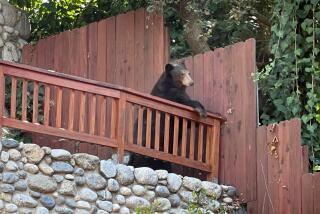Bornean Sun Bear Emerging From the Shadows
- Share via
SAN DIEGO — It’s not easy being on the same bill as a superstar.
If they could talk, the Bornean sun bears at the San Diego Zoo might give you an earful.
They’re small, sleek and cuddly-looking. They have one of the most distinctive markings in the animal kingdom: a crescent-shaped burst of color on their furry black chests. They’re an endangered species.
And they sometimes lock eyes with visitors -- giving a kind of “glad to see you” expression.
Yet they also live around the corner from one of the most popular animal species of all time: China’s giant pandas.
When the zoo’s female panda, Bai Yun, gave birth, it was a national sensation. But when its female sun bear, Marcela, gave birth to Danum -- the first Bornean sun bear born in North America -- it caused but a ripple.
Now, researchers at the San Diego Zoo are trying to unlock some of the mysteries of the sun bear’s reproductive process and social system and, as a side benefit, bring some attention to the unknown species.
“It’s amazing how much we don’t know about the sun bear,” said Barbara Durrant, the zoo’s top reproductive physiologist.
There is even disagreement among scientists about whether the Bornean sun bear is a distinct subspecies from the larger and better-known Malayan sun bear.
This much is known: Sun bears once roamed extensively throughout India, Myanmar, China, Laos, Vietnam, Thailand, Malaysia and Indonesia. Now their numbers are perilously low.
Their lowland forest habitat is being destroyed. They’re favorite targets of the “bush meat” trade. As the smallest members of the bear family -- adult Borneans weigh about 100 pounds -- they are often captured for sale as pets (the unwary don’t take into account those long claws and sharp teeth).
The San Diego Zoo has four Bornean sun bears: adult females Marcela and Ting-Ting, adult male Dibu, and male cub Danum, sired by Dibu.
The cub’s arrival in mid-February allowed researchers for the first time to watch the interactions of a sun bear family.
“Marcela’s teaching us all about Borneans and how they treat their young,” said zoo behaviorist Suzanne Hall.
Ting-Ting, however, is a problem bear. She doesn’t like Dibu and has resisted his entreaties to mate. The sight of Danum puts her ill at ease.
“She huffs and threatens if she sees keepers pay attention to the mother and cub,” said Randell Herron, keeper of the zoo’s Sun Bear Forest. “I’ve seen her transform into an angry chimpanzee grabbing palm fronds and banging the bars.” Just what Ting-Ting’s behavior says about sun bears, and how that might relate to helping the species survive in the wild, is among the many things researchers want to know.
Tests are being done on the bears’ feces, urine and vaginal secretions to learn about their reproductive cycle. The sun bear has been so obscure that researchers are not even sure how the female ovulates.
In late June, Durrant rushed to Seattle with a container of Dibu’s semen -- kept fresh by vaporized nitrogen at a temperature of minus-375 degrees -- after being alerted by keepers at Woodland Park Zoo that one of their female sun bears, Suntil, was in season.
The attempt at artificial insemination was unsuccessful.
Cheryl Frederick, Asian bear keeper at Woodland Park Zoo and coordinator of the North American Sun Bear Species Survival Plan for the American Zoo and Aquarium Assn., said she was not surprised, given the uncertainties of the process.
“It would have been like hitting the lottery on the first try,” she said.
With 18 Bornean sun bears at eight North American zoos -- Woodland Park has two females -- the addition of more cubs would help in research and in raising public awareness of the bear and its plight in the wild, said Frederick.
“It isn’t that the sun bear isn’t charismatic, it’s just that the pandas are so overwhelmingly charismatic,” she said. “There’s a reason the World Wildlife Fund [a leading conservation group] chose the panda as its symbol.” The San Diego Zoo’s official announcement of Danum’s birth noted that it was as significant to the sun bear species as Hua Mei’s birth in 1999 was to pandas -- the first successful birth for each species at a U.S. zoo.
“If you look at these guys, they’re adorable,” said Durrant, standing outside the sun bear grotto while Marcela pranced and Danum slept.
Her words had barely been uttered when a tourist family came strolling by. They slowed briefly to watch Danum and Marcela, then picked up their pace.
“Let’s go see the pandas now,” said Tourist Father.
“Yes, the pandas!” said Tourist Daughter.
More to Read
Sign up for Essential California
The most important California stories and recommendations in your inbox every morning.
You may occasionally receive promotional content from the Los Angeles Times.













